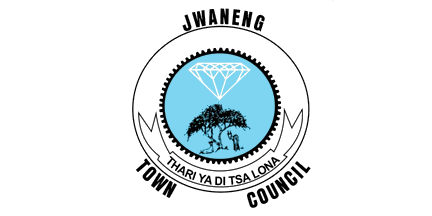
Last modified: 2019-08-18 by bruce berry
Keywords: botswana | jwaneng |
Links: FOTW homepage |
search |
disclaimer and copyright |
write us |
mirrors
 image by Ivan Sache, 09 June 2019
See also:
image by Ivan Sache, 09 June 2019
See also:
The municipality of Jwaneng (18,063 inhabitants in 2011) is located in southern Botswana, 150 km west of the capital, Gaborone.
The Jwaneng diamond pipe was discovered in the Naledi River Valley ("Valley of the Stars") in 1972 and now the Jwaneng Mine is the richest diamond mine in the world by value. The mine became fully operational in August 1982, when it was officially opened by the then President of Botswana. Construction of the mine and the adjacent township commenced rapidly, the former coming into full production in July 1982.
Jwaneng Mine is the flagship of Debswana [a joint-venture between the Government of Botswana and De Beers] due to substantially higher dollar per carat obtained for its gems. Jwaneng Mine contributes about 60-70% of Debswana’s total revenue.
Currently Jwaneng is mining to a depth of over 600 metres. The
resource consists of three separate volcanic pipes/vents namely; the north,
south and centre pipes (two additional small kimberlite bodies have also been
intersected within the pit). The pipes erupted through Transvaal strata and the
overlying Karoo sediments about 245 million years ago. Production is between
12.5 to 15 million carats per year.
Within the boundaries of the Jwaneng mining lease area, there is Jwana Game
Park, which measures 15 669 hectares and accommodates approximately 1 700
animals. The park also hosts a field unit of Cheetah Conservation Botswana, as
well as white rhinos (Source: Debswana
website).
Ivan Sache, 09 June 2019
The flag of Jwaneng has a white background with the Town Council's badge in
the centre, which is surrounded by the name of the town in black capital
letters. On the badge, the diamond represents the Jwaneng mine. The
tree and animal might represent Jwana Game Park.
Ivan Sache, 09 June 2019